Add this eBook to your basket to receive access to all 355 records. Our indexes include entries for the spelling hickey. In the period you have requested, we have the following 355 records (displaying 131 to 140): These sample scans are from the original record. You will get scans of the full pages or articles where the surname you searched for has been found. Your web browser may prevent the sample windows from opening; in this case please change your browser settings to allow pop-up windows from this site. Wesleyan Ministers
(1867)
The Wesleyan Methodist church in England and Ireland held annual conferences, abbreviated minutes of which were printed in the Wesleyan Methodist Magazine of September and October each year. These minutes include a complete list of the stations of the ministers for the coming year, with the names of the preachers 'on trial' and supernumeraries, arranged by district. The 32 British districts are covered, but not the ministers in Ireland or abroad. | Sample scan, click to enlarge
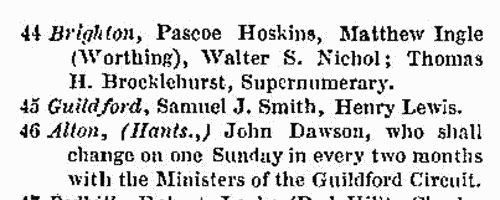
| Stockton-on-Tees Voters: Stockton Polling District
(1868)
This poll book for the First Parliamentary Election for the Borough of Stockton-on-Tees lists the voters alphabetically by polling district, with full name (surname first) and address. In the right-hand column D represents the Liberal candidate, Joseph Dodds, Esq., and V the Conservative, Lord Ernest Vane Tempest. The three polling districts were Norton, Stockton (including so much of Linthorpe as lay within the parliamentary borough of Stockton), and Thurnaby. At the end of each district the handful of lodger voters are listed separately. | Sample scan, click to enlarge

| Science Schools and Classes: Honours and Advanced Examinations: Class Lists
(1869)
The Science and Art Department of the Committee of Council on Education published these class lists giving the names of all the successful candidates in the examination of science schools and classes taken in May 1869. The candidates were of three levels: honours; second stage or advanced examination; third stage or elementary examination. Twenty-three subjects were offered. These are the lists for the honours and advanced examinations. The tables, arranged subject by subject, give the candidate's full name (surname first), age, and occupation - or, in the case of those not yet of working age, father's occupation, preceded by (f.); the name of the school where the candidate was taught the subject; and the name of the teacher. Many candidates sat and were successful in more than one subject, and so appear in more than one list. The subjects are: I. Practical, Plane and Solid Geometry; II. Machine Construction; III. Building Construction; IV. Elementary Mathematics; V. Higher Mathematics; VI. Theoretical Mechanics; VII. Applied Mechanics; VIII. Acoustics, Light, and Heat: IX. Magnetism and Electricity; X. Inorganic Chemistry; XI. Organic Chemistry; XII. Geology; XIII. Mineralogy; XIV. Animal Physiology; XV. Zoology; XVI. Vegetable Anatomy and Physiology; XVII. Systematic and Economic Botany; XVIII. Mining; XIX. Metallurgy; XX. Navigation; XXI. Nautical Astronomy; XXII. Steam; XXIII. Physical Geography. | Sample scan, click to enlarge

|  Men of the 57th Regiment who fought in the New Zealand War
(1860-1870) Men of the 57th Regiment who fought in the New Zealand War
(1860-1870)
New Zealand War Medal roll for the 57th (The West Middlesex) Regiment of Foot: for service in the New Zealand campaign 1863 to 1867: the rolls were compiled following a general order in 1869 and the medals were distributed in 1870. The regiment had been serving at Poonah in India, and was moved to New Zealand in November 1860; the men returned to England in April 1867. | Sample scan, click to enlarge

|  Outstanding soldiers of the 12th regiment of Lancers
(1860-1870) Outstanding soldiers of the 12th regiment of Lancers
(1860-1870)
The 12th (Prince of Wales's) Royal Regiment of Lancers, having returned from the Crimea, was sent off to India within a couple of months. The home depot was at Maidstone. By 1860 the regiment was serving at Secunderabad, but in that year returned to England; and served in Ireland 1865 to 1870. Each year just a handful of outstanding soldiers of the regiment were chosen for good conduct medals and gratuities: these are listed here. There were two lists, one for men recommended for the Good Conduct Medal without a gratuity, and one for gratuities - £5 to a private, £10 to a corporal, and £15 to a serjeant. Both lists are indexed here, and each gives rank, name, regimental number, date of recommendation and date of issue. (The sample scan is from the 105th foot) | Sample scan, click to enlarge
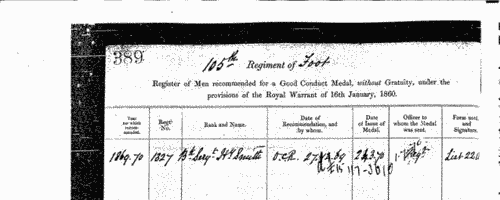
|  Outstanding soldiers of the 15th regiment of Foot
(1860-1870) Outstanding soldiers of the 15th regiment of Foot
(1860-1870)
The 15th (The Yorkshire East Riding) Regiment of Foot was in two battalions. The 1st battalion returned from Gibraltar in 1857. The home depot was at Pembroke, and in 1860 they were serving on Jersey; in that year the battalion was transferred to Ireland; to North America in 1862; to Bermuda in 1868; and back to Ireland in 1870. The second battalion was raised in England in 1858, and was sent to Malta; in 1863 to Gibraltar; and in 1868 to Ireland. Each year just a handful of outstanding soldiers of the regiment were chosen for good conduct medals and gratuities: these are listed here. There were two lists, one for men recommended for the Good Conduct Medal without a gratuity, and one for gratuities - £5 to a private, £10 to a corporal, and £15 to a serjeant. Both lists are indexed here, and each gives rank, name, regimental number, date of recommendation and date of issue. (The sample scan is from the 105th foot) | Sample scan, click to enlarge
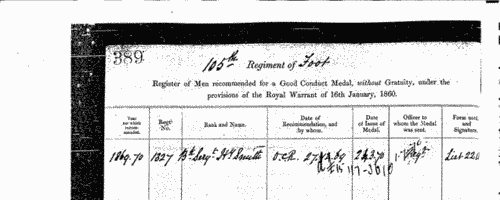
|  Outstanding soldiers of the 30th regiment of Foot
(1860-1870) Outstanding soldiers of the 30th regiment of Foot
(1860-1870)
The 30th (The Cambridgeshire) Regiment of Foot returned from Gibraltar in 1857, and was stationed at the Currah in 1860: the depot was at Parkhurst. In 1860 the troops were sent to the Channel Islands; in 1861 to England; then to Canada; and in 1868 to Nova Scotia, returning to Ireland in 1869. Each year just a handful of outstanding soldiers of the regiment were chosen for good conduct medals and gratuities: these are listed here. There were two lists, one for men recommended for the Good Conduct Medal without a gratuity, and one for gratuities - £5 to a private, £10 to a corporal, and £15 to a serjeant. Both lists are indexed here, and each gives rank, name, regimental number, date of recommendation and date of issue. (The sample scan is from the 105th foot) | Sample scan, click to enlarge
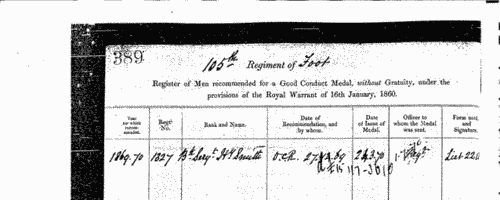
|  Outstanding soldiers of the 5th regiment of Foot
(1860-1870) Outstanding soldiers of the 5th regiment of Foot
(1860-1870)
The 5th Regiment of Foot (the Northumberland Fusiliers) was in two battalions. The 1st battalion embarked for Mauritius in 1847, and served in the East Indies. The home depot was at Colchester. The second battalion was based at Pembroke, but was sent abroad in 1858, and by 1860 was serving in Mauritius. Each year just a handful of outstanding soldiers of the regiment were chosen for good conduct medals and gratuities: these are listed here. There were two lists, one for men recommended for the Good Conduct Medal without a gratuity, and one for gratuities - £5 to a private, £10 to a corporal, and £15 to a serjeant. Both lists are indexed here, and each gives rank, name, regimental number, date of recommendation and date of issue. (The sample scan is from the 105th foot) | Sample scan, click to enlarge
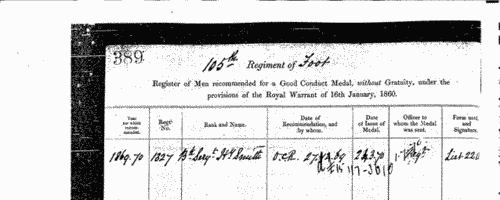
|  Outstanding soldiers of the 65th regiment of Foot
(1860-1870) Outstanding soldiers of the 65th regiment of Foot
(1860-1870)
The 65th (The 2nd Yorkshire North Riding) Regiment of Foot embarked for New South Wales in 1846, and was moved directly from there to New Zealand. It returned to England in 1865, and to Ireland in 1867: the regimental depot was at Birr. Each year just a handful of outstanding soldiers of the regiment were chosen for good conduct medals and gratuities: these are listed here. There were two lists, one for men recommended for the Good Conduct Medal without a gratuity, and one for gratuities - £5 to a private, £10 to a corporal, and £15 to a serjeant. Both lists are indexed here, and each gives rank, name, regimental number, date of recommendation and date of issue. (The sample scan is from the 105th foot) | Sample scan, click to enlarge
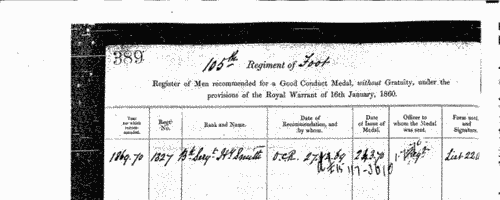
|  Outstanding soldiers of the 83rd regiment of Foot
(1860-1870) Outstanding soldiers of the 83rd regiment of Foot
(1860-1870)
The 83rd Regiment of Foot embarked for Bombay in January 1849, and took part in the suppression of the Indian Mutiny, adding "Central India" to the regimental colours. It returned to England in 1862: the regimental depot was at Chichester. In 1866 the regiment was sent to Ireland, in 1867 to Gibraltar, and in 1870 back to India. Each year just a handful of outstanding soldiers of the regiment were chosen for good conduct medals and gratuities: these are listed here. There were two lists, one for men recommended for the Good Conduct Medal without a gratuity, and one for gratuities - £5 to a private, £10 to a corporal, and £15 to a serjeant. Both lists are indexed here, and each gives rank, name, regimental number, date of recommendation and date of issue. (The sample scan is from the 105th foot) | Sample scan, click to enlarge
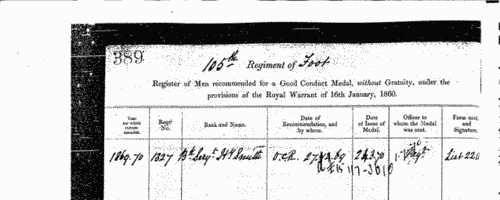
|
Research your ancestry, family history, genealogy and one-name study by direct access to original records and archives indexed by surname.
|












